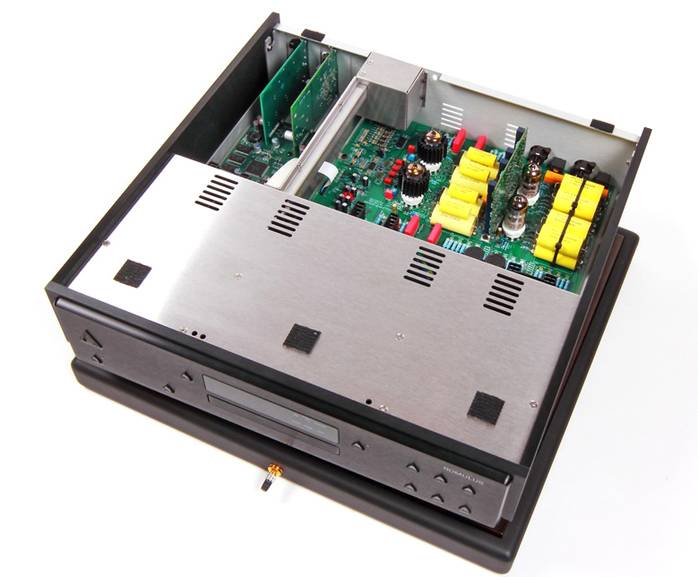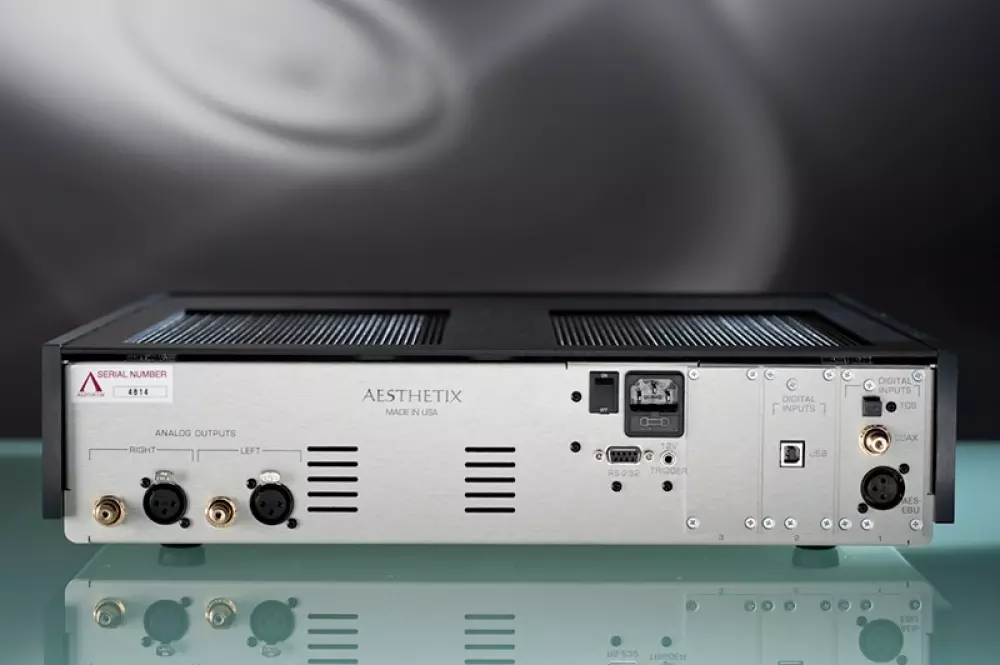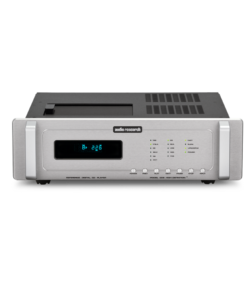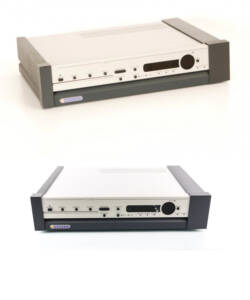Aesthetix Romulus Signature CD Player/DAC (Black)
Original price was: R277,000.00.R89,000.00Current price is: R89,000.00.
Aesthetix Romulus CD Player/DAC
- by Robert Harley
- Apr 14th, 2014

California-based Aesthetix has carved out an enviable niche producing very-high-performance products that, while not budget-priced, nonetheless offer extraordinary value. The company’s Calypso linestage, Rhea phonostage, Janus full-function preamplifier, and Atlas power amplifiers pack a lot of innovation, superb build-and parts-quality, and great sound into the upper-end, though not stratospheric, price category. (Aesthetix does, however, offer two mega-priced, ultra-tweaky products, the Io Eclipse phonostage and Callisto Eclipse linestage.)
Aesthetix has now complemented its more affordable line with the addition of the Romulus CD player/DAC. In keeping with the company’s signature technology, the Romulus features a tubed output stage. In addition to spinning CDs, the Romulus can accept a digital input in a variety of formats including USB. For those of you who have dispensed with CD, Aesthetix’s Pandora DAC is identical to the Romulus sans disc transport.
Technical Description
The $7000 Romulus has a fixed output level for use with preamplifiers. For an additional $1000 the Romulus includes a variable output for driving a power amplifier directly. The large front-panel display doubles as a volume control—push the right side to increase the volume and the left side to decrease. The circuit that realizes this variable output exemplifies Aesthetix’s innovation and commitment to sound quality. Rather than simply attenuate the signal in the digital domain and accept the resolution loss (every 6dB of digital-domain attenuation is equivalent to throwing away one bit of resolution), Aesthetix has combined analog and digital attenuation in a novel circuit. Decreasing the output level attenuates the signal in the digital domain just as in other DACs with a variable output. But when you reach 6dB of attenuation, a relay engages resistors that replace the 6dB of digital-domain attenuation with 6dB of analog-domain attenuation, resetting the digital-domain level to full scale. Voîlà!—variable output without any meaningful loss of resolution at any output level. In practice, this transition from digital-domain to analog-domain attenuation is transparent to the user, save for a relay click when every 6dB threshold is crossed. The volume steps are 1dB, which is a little coarser than what is found in most DACs, but I didn’t find it a problem. The variable output circuit is, incidentally, housed on a board that plugs in vertically to the horizontal motherboard.
The Romulus incorporates other interesting design techniques, including a SPDIF receiver and clocking circuit based on a fixed-crystal clock. Most SPDIF input receivers are built around a VCXO (voltage-controlled crystal oscillator), whose output frequency can be adjusted by an external voltage. By “pulling” the clock frequency slightly the DAC can lock to the incoming clock rate. A VCXO, however, isn’t quite as precise as a fixed-frequency crystal. Aesthetix solves this problem by using a fixed-frequency crystal and running the data through a memory buffer. Presumably the buffer is large enough to “fill up” sufficiently before outputting the data so that the buffer doesn’t run empty if the Romulus clock is faster than the incoming clock, or conversely so that the buffer doesn’t overflow if the Romulus clock is slower than the incoming clock. In practice, there’s no time lag between pressing “Play” and hearing music, suggesting that a larger buffer isn’t required.
The SPDIF inputs are galvanically isolated so that ground noise on source components doesn’t get into the Romulus. They can accept datastreams up to 192kHz/24-bit. The input circuits are housed on removable boards to allow future upgrades as new interfaces become available. The same crystals used in the SPDIF input receiver are also used in the USB input circuit. It goes without saying that the USB input is asynchronous, meaning that the Romulus serves as the master clock to which the USB source must lock. Other digital inputs include TosLink optical and AES/EBU.
The 8x oversampling digital filter software is written in-house by Aesthetix, and runs on a Motorola DSP56362. Creating a custom filter is considerably more expensive and time-consuming than buying an off-the-shelf filter chip (or using the filter built into most DACs these days), but allows the designer to employ more sophisticated filtering techniques, and to tailor the filter’s sound to the context of the entire product. The digital filter has a large effect on the product’s sound, which is why many DACs that use the same filter/DAC chip sound quite similar.
The filter’s differential outputs (+ and –, or the datastream and the datastream inverted) are converted to analog by a Burr-Brown PCM 1792 chip operated differentially. With four DACs in one package, the PCM 1792 can process the L+, L-, R+, and R- separately. The downstream signal path—current-to-voltage converter, gain stage, and output buffer—is also balanced all the way to the XLR jacks. This is the right way to create a balanced analog output signal. The less expensive, but more common, alternative is to convert the digital signal to analog with one DAC and one analog signal path per channel, and then create a “balanced” signal with a phase-splitter just before the XLR jacks. Not only does this latter technique add an additional active stage to the balanced signal path, but it also doesn’t realize the benefit of differential DACs. One of these benefits is that any noise or distortion common to both DACs will cancel when the balanced signal is eventually summed, not to mention the increase in signal-to-noise ratio.
The output stage comprises a 12AX7 gain stage followed by a 6DJ8 output buffer. The circuit has zero global feedback. Tube-rollers can supply their favorite 12AX7s and 6DJ8s, but I evaluated the Romulus with the stock tubes.
The power supply is large and elaborate, with multiple regulated stages for powering different subsections. Even the analog, digital, and clocking sections of the PCM1792 DAC are fed from independently regulated supplies, each with cascaded discrete regulation stages. “Discrete” regulation means that the voltage regulators that maintain a constant DC supply voltage to the circuit are built from separate transistors (along with the peripheral parts that make them work). Discrete regulation is contrasted with IC regulation in which the regulator is simply an inexpensive three-pin integrated circuit. “Cascaded” means that the output of a voltage regulator feeds the input of another regulator, further purifying the DC that powers the audio circuit. Cascaded discrete regulation is expensive and consumes circuit-board real estate, which is why it’s usually only found in mega-priced products.
The input section, along with the Motorola DSP chip on which the filter runs, is powered by a separate power transformer and multiple independently regulated power-supply stages. The front-panel display and control section are also powered from a dedicated transformer. The 12AX7 in the gain stage, as well as the 6DJ8 output buffer, is fed from multiple supplies, including regulated heater supplies.
It’s impossible to overstate the power supply’s sophistication, particularly considering the Romulus’ $7000 price; such implementations are usually reserved for cost-no-object products. I suspect that this approach to the power supply, if not to the circuits themselves, was derived from the development work on Aesthetix’s flagship Io and Callisto. Having designed the best possible products without regard to price, designer Jim White knows exactly what effect power-supply topologies and parts-quality has on the sound, and is able to make the most intelligent trade-offs. Incidentally, White spent many years at Theta Digital before founding Aesthetix.
I should mention that the Romulus is available in a “Signature” edition that features the identical circuit, but with upgraded passive components and isolation feet. The upgraded components include the same expensive capacitors found in the Io and Callisto. When I compared Aesthetix’s Rhea phonostage to the Rhea Signature (whose only difference was passive parts-quality) a few years ago I heard a substantial improvement in the Signature version. The Signature edition costs $10,000 with fixed-level outputs, and $11,000 with variable-level outputs.
Listening
From the first CD, the Romulus impressed with its big, open, and expansive sound. It’s interesting how source components can allow a pair of loudspeakers to disappear into the soundstage— or not. Playing a CD that has captured a tremendous sense of space such as Dick Hyman’s Swing is Here on Reference Recordings made it immediately apparent that the Romulus didn’t suffer from the common CD ailments of congealing images and sounding bright without top-octave air. In fact, the Romulus was among the most open and airy digital products I’ve heard—at any price. The soundstage had wonderful dimensionality and depth, coupled with a sense of being “illuminated from within,” a wonderfully evocative phrase coined by Jonathan Valin to describe the classic Audio Research sound. Instruments toward the rear of the soundstage were presented with their tonal colors and spatial qualities fully realized, rather than blending indistinctly into the foreground.
Although the Romulus had tremendous bloom and air, it would be a mistake to interpret this as an artifact of a tubed output stage. On the contrary, image focus was tight and well defined, and the overall perspective was just a bit on the immediate and incisive side—not characteristics of a “tubey” sound. Nothing in the presentation suggested that I was listening to tubes, except the lack of a metallic, brittle character in the treble. The contrast between the up-front midrange presentation and the ability to see way back into the hall produced a soundstage of remarkable depth. The musical benefit was an ability to easily follow individual instrumental lines, no matter how complex the music or how subtle those lines—one of analog’s great strengths, incidentally.
The bass was remarkably rich, full, and weighty, yet still maintained a sense of speed and precision. The Romulus’ big bottom end served as the anchor for the rest of the presentation, beautifully conveying everything from the dense textures of orchestral doublebasses to the purring of a Fender Precision. Again, the Romulus didn’t sound like a tubed unit in its bottom-end impact, dynamic agility, and articulation. The midbass had a meaty quality that did wonders for an orchestra’s power range and some bass-guitar playing. On the title track from Donald Fagan’s Morph the Cat in 96kHz/24-bit the Romulus had tremendous low-end grip and power that conveyed the track’s visceral physicality. The Romulus is the antithesis of thin, threadbare, lean, or bleached.
The more I listened to the Romulus the more I enjoyed it musically, and the more I admired its sonic achievement. That statement may sound like a tautology, but some products can sound stunning sonically but fail to connect musically. The classic example is the super-high-resolution, dead-quiet, lightning-fast component that lays bare every last detail in a recording yet fails to engage the heart. It’s like a musician who shows off his astounding technical chops but has nothing to say. In digital products, this often results from a kind of mechanical quality that doesn’t really convince your brain that you’re hearing musical instruments rather than a collection of sounds. Such a product may hit many of the audiophile buttons, but there’s something not quite right—the presentation is built on an artificial foundation. The Romulus’ great appeal is that it avoids this pitfall completely. It sounds extremely “organic” and natural, without a hint of synthetic patina, particularly in the treble.
I’m glad that the review sample had the variable-output option installed, because driving a power amplifier directly revealed just how great this player is. The dynamic expression widened, the bass was fuller and went deeper, and transparency increased. It was comforting to know that no matter what the playback level (i.e., the amount of attenuation in the Romulus) I wasn’t losing resolution.
Fronting a world-class reference system of Constellation Centaur monoblocks driving Magico Q7 loudspeakers via MIT’s Oracle MA-X interconnect and MA-X SHD loudspeaker cables, the Romulus acquitted itself nicely under this ultra-high-resolution “microscope.” In fact, this system’s resolving power only emphasized what a terrific-sounding player the Romulus is; a lesser player’s flaws would have been that much more evident. Moreover, I compared the Romulus directly to what is unquestionably the state of the art in digital playback, the dCS Vivaldi. Of course, the Romulus was not the Vivaldi’s equal, but let’s just say that my opinion of the Romulus went up another few notches after this comparison when I reflected on the fact that the Vivaldi DAC and transport cost nearly ten times more than the Romulus.
Driving the Romulus through its USB port with a MacBook Pro running iTunes and Pure Music revealed the USB implementation to be excellent, although I preferred the sound of CDs played in the Romulus’ transport compared to rips of those CDs. The bass was fuller and better controlled, the midrange and treble smoother, and the soundstage more expansive. Remember, however, that the USB cable and the computer setup are significant variables when using a computer source.
Conclusion
The Romulus is another home run for Aesthetix, combining innovative circuit design, premium-quality parts and construction, and first-rate sound. This player was never anything less than musically communicative and immensely enjoyable, even in the context of a cost-no-object system. The Romulus is a flat-out bargain at its price, and invites comparison with much more expensive players. In fact, I’d call the Romulus a giant-killer, offering one of the highest price-to-performance ratios in digital playback today.
| Digital sources built over the last few years have offered far more sophisticated sound than earlier ones. The same goes for D/A converters which is almost implied but also CD/Bluray decks. At the time of publication I reviewed the multi-format Marantz UD7007 and Cambridge Audio Azur 752BD for Audio magazine. I was surprised by how mature both sounded regardless of what type disc I spun or what sort of files I streamed. There are many reasons why such progress was possible. One was finding ways to deal with jitter’s time distortion. The other was that manufacturers finally realized that music is not just a group of sounds that must be delivered in the most precise fashion. They finally realized how complex music signal really is, how many subtle connections between timbre, pace, resolution, selectivity, focus, micro and macro dynamics must be acknowledged to obtain truly good sound. | ||||||||||||||||||||||
 |
||||||||||||||||||||||
| The interesting thing about the former factor (which is obviously just my opinion) came strictly from engineering work. Jitter was measured, recognized and addressed. Truth be told, jitter measurements only took off once audiophiles complained that their CD players sounded less perfect than expected. The latter arrived from listening sessions that helped us understand correlations between various elements of music that must be reproduced to make playback natural. Taking into account both hard data from measurement-driven engineering and soft data from subjective listening allowed manufacturers to arrive at the point today where really good-sounding digital has become possible. One has to be impressed most by the improvements in the low-price level which goes for D/A converters like Cambridge Audio’s DACMagic 100, Arcam’s rDAC and rLINK or the Cambridge Audio Topaz 5 CD player. Each of them costs less than any one part of my system. It’s a real pleasure to find such gems amongst inexpensive machines and I’m pretty sure it was no easy task to make them sound as good as they do. Equally significant changes are happening in the high-end. The character of changes is similar to those already described but their consequences are much more complex. | ||||||||||||||||||||||
 |
||||||||||||||||||||||
Yet what connects the entry-level rLINK and today’s high-end Romulus still are the choices designers must make during the R&D process. There simply is no ultimate natural, neutral or absolute sound per se. What you may achieve is a bit less or more than this natural/neutral sound. And it gets more complicated. Two decks one might describe as similar in neutrality and/or naturalness will in general still sound very different, possibly day and night so. Think Romulus and M2Tech Vaughan DAC.
|
Description
SPECS & PRICING
Inputs: USB, AES /EBU, SPDIF coaxial, TosLink
Outputs: Balanced on XLR jacks, unbalanced on RCA jacks
USB input: Up to 192kHz/24-bit
Tube complement: 12AX7 (x1), 6DJ8 (x1)
Dimensions: 17.875″ x 4.25″ x 18.125″
Weight: 30 lbs. (net)
Price: $8000 with variable output ($7000 fixed-level)














